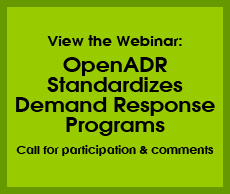QualityLogic Leads Development of OpenADR Program Guide

QualityLogic’s Jim Zuber, noted expert and trainer on OpenADR technology, has been working with the OpenADR Alliance Technical Committee to develop and write an OpenADR Program Guide. The guide was introduced in a webinar July 28, and comments will be accepted up to four weeks after that date. View the webinar.
The target audiences for the guide are utilities and their partners planning to deploy Demand Response (DR) programs that use OpenADR 2.0 for communicating DR event related messages.
There is no such thing as a standardized DR program. Each DR program design tends to be unique, fitting the structural and regulatory requirements of the geographic region it is deployed in. For each DR program there are numerous possible deployment scenarios involving a variety of actors. This variability is for the most part a reflection of the fragmented and complex nature of the North American electric grid.

It is helpful to DR Program designers to have detailed examples of typical Automated DR programs to be used as models for their own implementations. Equipment manufacturers need to understand typical DR Program usage models so they can validate interoperability as part of the development process rather than on a deployment-specific basis. The intent of the guide is to accomplish both these goals as follows:
- Define a small set of standard DR Program templates modeled after the common characteristics of the most popular DR programs implemented to date
- Define a small set of deployment scenarios modeled after real world deployments, with actors and roles clearly identified
- Define best practices recommendations for OpenADR characteristics specific to each of the DR Program templates
- Provide a decision tree that can be used to identify the useful DR program templates and deployment scenarios based upon their business needs of the program owners and designers
The Guide provides six different deployment scenarios covering direct and aggregator deployments of OpenADR messaging to facilitate DR Program operations. It further details six templates that cover Critical Peak Pricing, Residential Thermostat, Fast DR Dispatch, EV DR, and DER Programs implemented with OpenADR messaging.
The chapter on selecting a DR Program Template walks users through a series of key questions to help decide which template is most appropriate for their needs. Questions include:
- Why do you want to do a DR Program? What grid condition or operational issue are you trying to mitigate with DR?
- Is there an existing DR program or tariff already in place for this program?
- What demand side market segment are you targeting with this program?
- Are you trying to target specific types of loads?
- What is your deployment model?
- What interaction pattern do you want to employ to influence your customers load profiles?
- What is the general resource scheduling attributes of the program?
- At what level of specificity do you want to interact with the demand side loads?
- How is the availability of resources in the program determined?
- What type of visibility do you need into the resource’s performance?
The DR Program Characteristics include 24 specific characteristics for each DR Program Template. These include specifics for Rate Design, Target Load, Program Time Frames, OpenADR Event Signal characteristics, OpenADR Opt In/Opt Out Responses, etc.
Finally, the Program Guide provides Sample Data and Payloads for each Program Template. This assists those actually implementing the programs in OpenADR with starting points for creating specific programs.
The 74 page Program Guide is currently at V0.91 and a review draft will be distributed to all those interested in providing input and comments. The guide was introduced in a webinar hosted by OpenADR Alliance Technical Director Rolf Bienert and QualityLogic CTO Jim Zuber – View Webinar.
QualityLogic is pleased to be able to contribute to this valuable document and looks forward to comments from a broad set of stakeholders interested in successful implementations of OpenADR.